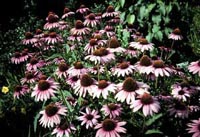Resource Library
Plant of the Week: Purple Coneflower (Magnus Coneflower)
The University of Arkansas System Division of Agriculture does not promote, support or recommend plants featured in "Plant of the Week." Please consult your local Extension office for plants suitable for your region.
Plant of the Week
Magnus Coneflower
Latin: Echinacea purpurea 'Magnus'

Even though my cold didn’t go away any faster than usual, I still like this plant.
The purple coneflower is an herbaceous perennial that is native to Arkansas and has
gained widespread notoriety in recent years as a good garden plant and as the hottest
selling herbal supplement in the rapidly expanding field of herbal medicine. According
to herbal experts and a fairly significant body of scientific evidence, Echinacea
works as an immune system stimulant and lessens the severity of colds and other immune
system insults.
It is not recommended as a preventative treatment for colds, but should be taken
at the first sign of a cold and is said to speed the recovery time two to three days.
The roots and tops of purple coneflower are used in the herbal remedy with much of
the plant production going on in the Pacific Northwest.
Purple coneflower is a wildflower that has migrated from the wild to become a mainstream
garden perennial in just the last 25 years. As with many of our native plants, European
gardeners were the first to recognize its garden worthiness and spearhead the widespread
garden use of purple coneflower. The cultivar Magnus was selected by one of these
European nurserymen for its compact habit of growth and flat flower head. Perennial
plant growers are so enamored with Magnus that they bestowed the title of National
Perennial Plant of the Year for 1998.
Magnus purple coneflower grows up to 30 inches tall and, in old plants, can spread
that wide. From late May until early July, it produces 3- to 4-inch wide daisy-like
flowers with pinkish-purple petals and a prominent black central cone.
The plants hold the flowers well above the clean foliage, on stems that are plenty
long for cutting. If faded flowers are cut back, additional blooms will be encouraged.
But, if the seed heads are allowed to form, small seed-feeding birds such as finches
will find their way to the plants and brighten the garden after the flowers have faded
from memory.
Magnus purple coneflower is one of the five plants that were chosen as a 1999 Arkansas
Select plant. The Arkansas Select plants were chosen from the group of plants nominated
by experts across the state such as nurserymen, greenhouse producers and university
and extension personnel. These plants were judged to do well across the state, to
be relatively underused in gardens and to be pest free. All five Arkansas Select plants
will be available from most Arkansas greenhouses and nurseries this spring at the
appropriate planting season.
Growing Magnus purple coneflower in the garden is easy because the plant is not only
beautiful, it is adaptable. It seems to grow about as well in full sun as in part
shade, but in shade it will be just a bit taller. Like most perennials, it does best
when given a reasonably fertile, well drained planting site, but it is by no means
finicky and will thrive in the mixed perennial border with even the most competitive
neighbors. Once established it is very drought tolerant. Insects and diseases are
not a problem of this plant.
By: Gerald Klingaman, retired
Extension Horticulturist - Ornamentals
Extension News - April 9, 1999
The University of Arkansas System Division of Agriculture does not maintain lists of retail outlets where these plants can be purchased. Please check your local nursery or other retail outlets to ask about the availability of these plants for your growing area.